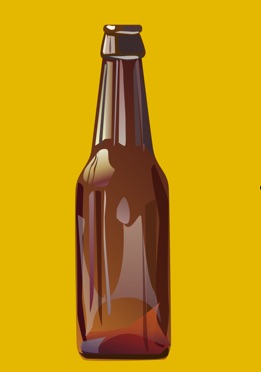Buy a print
BROWN BOTTLE
Beer is the most widely consumed alcoholic beverage in the world and is the third most popular drink after water and tea. Beer bottles are part of the 500 glass containers that each UK family uses in a year.
We currently recycle around 50% of this glass and, while this figure has doubled over the last five years, we still lag behind both Switzerland and Finland who recycle more than 90%. It is important for us to improve our recycling as the largest UK furnace produces over 1 million glass bottles and jars each day.
HISTORY
Stoneware bottles were common in the 18th and early 19th century. They were slowly replaced by stubby brown glass that was ideal for heavier, less carbonated, ales and porters. But the taste for bottle conditioned beer led to the design of a thick and robust ‘Export’ design which was popular throughout the 19th and early 20th century. The thinner modern bottle is made from brown glass which protects the contents from UV light and prevents spoilage.
MAKING
The brown beer bottle is made from molten glass which is heated to some 1200 degrees celsius. A shearing blade cuts the soft glass into a number of short cylinders, called ‘gobs’. The cut gobs fall and roll through a passage to the moulds. A metal plunger presses the gob into the blank mould, where it assumes its basic shape. It is then termed a ‘parison’. The parison is moved into a final mould, where it is blown to assume the bottle shape before being cooled and solidified.
DRAWING
The overall form creates beautiful refections which break up and transform as the shape changes from cone to cylinder. The brown glass colours and distorts the background and reflects the objects around it to create a tantalisingly simple and beautiful object. The bright highlights, the mid tone reflections and the dark shadows are all influenced by the different forms and so create the sense of volume.













